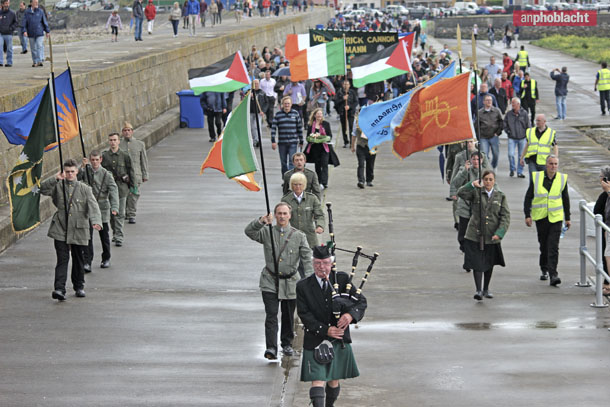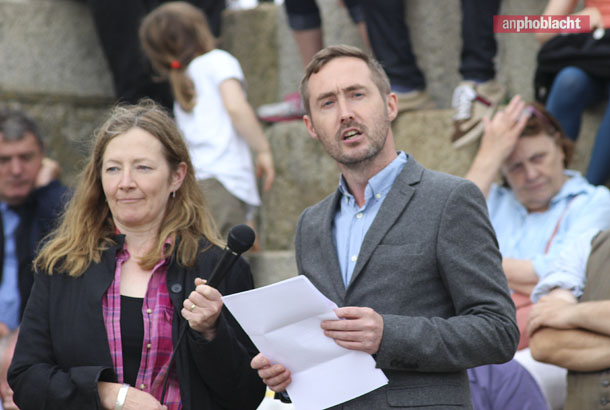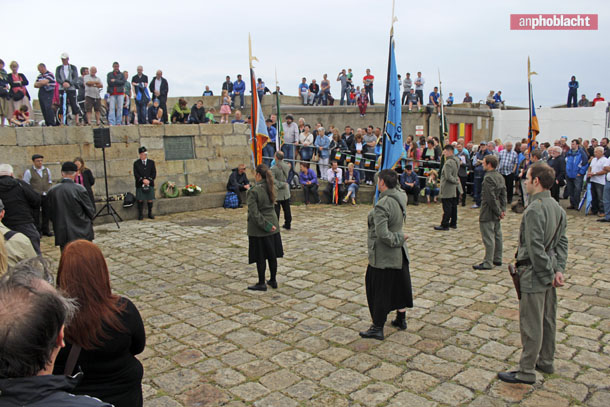26 July 2014
Asgard 26 July 1914 – Commemoration of ‘Howth Gun Running' for 1916

The Commemoration makes its way down the East Pier, Howth
Speech delivered by County Councillor and Sinn Féin Ard Chomhairle member Eoin Ó Broin at the commemoration at Howth Pier, County Dublin, marking the 100th anniverary of the Asgard landing weapons there on 26 July 1914 in preparation for the 1916 Rising.
ONE HUNDRED YEARS AGO TODAY, on this very pier, members of Fianna Éireann and the Irish Citizen Army stood ready to land a shipment of arms destined for the Irish Volunteers.
The landing was an important step in preparation for the 1916 Rising.
But the events in Howth on that day were much more than a practical matter of guerrilla war.
It was an act of political defiance.
It was a bold step by women and men who were determined to wrestle Ireland’s destiny from the clutches of the British Empire.
It was a signal of intent that Irish women and men were no longer willing to be subjects of a foreign monarch.
It was a declaration of Irish citizenship and an assertion of the right of Irish citizens to control our own destinies.
Some of the leading figures in the Rising were involved in the Asgard mission.
Constance Markievicz stood ready, wheelbarrow in hand, overseeing the events on this pier. Republican, socialist, feminist, she was already an iconic figure in the republican struggle. She would go on to become the first woman Cabinet minister in the world.
Erskine Childers was the skipper. A leading member of Sinn Féin, a TD for Wicklow, a republican Director of Publicity in the Civil War and, finally, executed by the Free State in November 1922.
Molly Childers was one of the fund-raisers for the operation and helped navigate the ship en route to Ireland.
Erskine, Molly and their crew made the journey from Hamburg through the North Sea, sailing unsuspected through the entire Royal Navy Home Fleet while it was being inspected by the King of England and encountering the worst storm in years in the Irish Sea.
The Citizen Army and the Fianna landed the arms and marched back to Dublin.
At Fairview, the Royal Irish Constabulary attempted to thwart them but they got away.
In response to the landing of the arms, soldiers of the King’s Own Scottish Borderers regiment opened fire on a crowd in Bachelor’s Walk in the city centre, killing three civilians: Mrs Duffy, James Brennan and Patrick Quinn; 38 more were injured, one of whom died later of bayonet wounds.
The Bachelor’s Walk killings stood in sharp contrast to the co-operation given by the British crown forces to the Ulster Volunteers when they had landed thousands of weapons at Larne earlier that year.
The mission was a success but it came at a very heavy price.
The landing of the Asgard here in Howth in 1914 was a key moment in the struggle for Irish independence.
It not only provided the Volunteers with the means to take on the Empire – it gave them the confidence.

Today we remember those women and men who played such an important part in the long struggle for Irish independence.
But we are here to do much more than just remember their actions.
We are here to remember the reasons behind those actions – the political ideals that motivated these men and women.
We are here to celebrate and to draw inspiration from their bravery and their determination.
Like Sinn Féin today, the women and men of 1914 were struggling for a New Republic – independent, democratic and equal.
Five years after the Asgard landing, Irish republicans set out what that republic should look like when, in 1919, at the first sitting of Dáil Éireann, the democratically-elected representatives of the Irish people unanimously endorsed the Democratic Programme.
That Programme took the 1916 Proclamation’s vindication of “the right of the people of Ireland to the ownership of Ireland, and to the unfettered control of Irish destinies” as its starting point and went on to detail the social and economic meaning of this fundamental republican principle.
The Programme asserted that “sovereignty extends not only to all men and women of the nation, but to all its material possessions, the nation's soil and all its resources, all the wealth and all the wealth-producing processes within the Nation”.
The Programme also prioritised the public interest over the private, affirming “that all right to private property must be subordinated to the public right and welfare”.
The new republic was to be “ruled in accordance with the principles of Liberty, Equality, and Justice for all” and was to guarantee the “right of every citizen to an adequate share of the produce of the nation's labour”.
The document stated:
“It shall be the first duty of the Government of the Republic to make provision for the physical, mental and spiritual well-being of the children, to secure that no child shall suffer hunger or cold from lack of food, clothing, or shelter, but that all shall be provided with the means and facilities requisite for their proper education and training as citizens of a free and Gaelic Ireland.”
The newly-established government was to have a “duty to promote the development of the nation's resources, to increase the productivity of its soil, to exploit its mineral deposits, peat bogs, and fisheries, its waterways and harbours, in the interests and for the benefit of the Irish people”.
The final lines of the Programme committed the new government to promote a “general and lasting improvement in the conditions under which the working classes live and labour”.
The Democratic Programme outlined both the values and mechanisms through which the social and economic promise of the republican revolution was to be delivered.
It not only promised political equality but economic and social equality too.
It was a radical Left republican manifesto combining all that was progressive in the socialist and republican traditions of its authors.
This is the vision that inspired Constance Markievicz and her comrades on Howth’s East Pier 100 years ago today.
It is the same vision that motivates those of us assembled on that very same pier today.
The struggle for the New Republic continues.
But we are no longer landing guns in preparation for military confrontation.
We are mobilising the hearts and minds of the people of Ireland.
We are building our political strength on the streets, in our communities, across council chambers and in the Assembly, Dáil and European Parliament.

We are building a movement for political, social and economic change in Ireland.
We are no longer taking a stand against an Empire – our ambitions are much greater than that.
We are in the business of taking power in Ireland – North and South- in order to implement the New Republic outlined in the Democratic Programme of 1919.
So, as we stand assembled here today, we must do more than just commemorate. We must take inspiration from the courage and vision of those who came before us.
We must go away from today’s proceedings and rededicate ourselves to the struggle for a fully independent, truly democratic and genuinely equal republic.
That is what the republican and socialist Volunteers on Howth Pier were struggling for in 1914.
That is what Sinn Féin is struggling for today.
That is what you must struggle for tomorrow and every day until the vision of the Republic as outlined in the Democratic Programme becomes a reality.
![]()
See also short video Roads to Revolution 1916 (Part I): The Landing of the Asgard
Follow us on Facebook
An Phoblacht on Twitter
Uncomfortable Conversations

An initiative for dialogue
for reconciliation
— — — — — — —
Contributions from key figures in the churches, academia and wider civic society as well as senior republican figures





